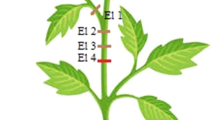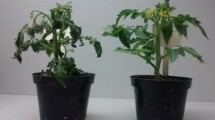Summary
In a study of membrane potential properties of giant cells induced in the roots ofImpatiens balsamina by a rootknot nematode, trains of action potential-like fluctuations were recorded. Giant cells are multinucleate transfer cells, and it is suggested that the occurrence of action potentials may be characteristic of transfer cells.
Similar content being viewed by others
References
Bird, A. F., 1959: Development of root-knot nematodesMeloidogyne javanica (Treub) andMeloidogyne hapla (Chitwood) on tomato. Nematologica4, 31–42.
Eckert, R., 1965: Bioelectric control of bioluminescence in the DinoflagellateNoctiluca. Science147, 1140–1142.
Etherton, B., 1968: Vacuolar and cytoplasmic potassium concentrations in pea roots in relation to cell-to-medium electrical potentials. Plant Physiol.43, 838–840.
Jones, M. G. K., andD. H. Northcote, 1972: Multinucleate transfer cells induced inColeus roots by the root-knot nematode,Meloidogyne arenaria. Protoplasma75, 381–395.
—,A. Novacky, andV. H. Dropkin, 1973: Membrane potentials of transfer cells. Plant Physiol.51 (suppl.), 16.
Mackie, G. O., 1970: Neuroid conduction and the evolution of conducting tissues. Quart. Rev. Biol.45, 319–332.
Molotok, G. P., E. A. Britikov, andA. M. Sinyukhin, 1968: Electrophysiological and functional activity of the nectaries of lime on mechanical stimulation. Proc. nat. Acad. (U.S.S.R.)181, 750–753.
Novak, B., andF. W. Bentrup, 1972: An electrophysiological study of regeneration inAcetabularia mediterranea. Planta (Berl.)108, 227–244.
Pate, J. S., andB. E. S. Gunning, 1972: Transfer cells. Ann. Rev. Plant Physiol.23, 173–196.
Pickard, B. G., 1973: Action potentials in higher plants. Bot. Rev.39, 172–201.
Sibaoka, T., 1966: Action potentials in plant organs. Symp. Soc. exp. Biol.20, 49–73.
—, 1969: Physiology of rapid movements in higher plants. Ann. Rev. Plant Physiol.20, 165–184.
—, 1973: Transmission of action potentials inBiophytum. Bot. Mag. (Tokyo)86, 51–61.
Sinyukhin, A. M., andE. A. Britikov, 1967: Generation in the pistils ofIncarvillea and Lily in conjunction with movement of the stigma and fertilization. Soviet Plant Physiol.14, 463–475.
Slayman, C. L., 1965: Electrical properties ofNeurospora crassa. J. gen. Physiol.49, 69–92.
Williams, S. E., andB. G. Pickard, 1972: Properties of action potentials inDrosera tentacles. Planta (Berl.)103, 222–240.
Author information
Authors and Affiliations
Rights and permissions
About this article
Cite this article
Jones, M.G.K., Novacky, A. & Dropkin, V.H. “Action potentials” in nematode-induced plant transfer cells. Protoplasma 80, 401–405 (1974). https://doi.org/10.1007/BF01276355
Received:
Issue Date:
DOI: https://doi.org/10.1007/BF01276355




